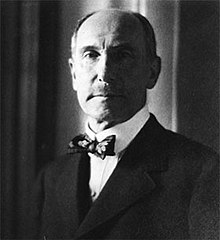Charles L. Freer
| Charles Lang Freer | |
|---|---|

1916 photograph portrait by Edward Steichen.
|
|
| Born |
February 25, 1854 Kingston, New York, United States |
| Died | September 25, 1919 (aged 65) New York City, New York, United States |
| Resting place | Wiltwyck Cemetery 41°55′24.4″N 74°00′21.2″W / 41.923444°N 74.005889°W |
| Residence |
Charles Lang Freer House Detroit, Michigan, United States |
| Occupation | Businessman |
| Known for | Collector of Asian and American art. |
Charles Lang Freer (February 25, 1854 – September 25, 1919) was an American industrialist, art collector, and patron. He is known for his large collection of East Asian, American, and Middle Eastern Art. In 1906, Freer donated his extensive collection to the Smithsonian Institution, making him the first American to bequeath his private collection to the United States. To house the objects, including The Peacock Room by James McNeill Whistler, Freer funded the construction of the Freer Gallery of Art in Washington, DC.
Charles Lang Freer was born in Kingston, New York, United States, in 1856. The third child of six, his family had little money and at the age of 14, Freer's mother died. After the seventh grade, Freer left school and took a job in a cement factory. In the early 1870s, Freer was noticed by Frank J. Heckler, then general superintendent of the New York, Kingston, & Syracuse Railroad, while working as a clerk in a general store. Heckler capitalized on Freer's accounting and organizational skills, hiring the young man as his paymaster and accountant in 1874. In the 1870s, a group of investors from Detroit decided to build a rail line in Logansport, Indiana; they hired Hecker to manage the project. Hecker brought the younger Freer along.
In 1879, using connections made in the railroad business and the financial backing of a group of Christian H. Buhl, James Joy, Russell Alger, James McMillan, and Allan Shelden, Freer and Heckler moved to Detroit, where they created the Peninsular Car Company in 1885. The business made both men wealthy and Peninsular became Detroit's second largest car manufacturer. In 1892, Peninsular merged with the Michigan Car Company, taking over the majority of the railcar market in Detroit. At the time, Michigan-Peninsular Car was Michigan's largest manufacturer. Seven years later, in 1899, Freer organized a 13-company merger, creating American Car and Foundry in 1899.
...
Wikipedia
